#1940s style 1900s fashion
Explore tagged Tumblr posts
Text
#fashion#20th century#1920s fashion#1930s fashion#1940s fashion#1900s fashion#1910s fashion#1950s fashion#1960s fashion#1970s fashion#1980s fashion#1990s fashion#clothing#fashion history#vintage style#vintage fashion
155 notes
·
View notes
Text


1939 - 1940
#1939#1940#history#historical#fashion history#fashion#historical fashion#1900s#1930s#1940s#1930s fashion#1930s style#1940s fashion#1940s style#40s#black and white#history tag#1900s photography#vintage photos#vintage#vintage fashion#vintage photography#vintage beauty#20th century fashion#20th century#early 20th century#antiquebee
11 notes
·
View notes
Note
Regarding silhouettes being key to recreating a certain decade's look and vibe: do you have any useful references for larger-bodied people? As a fat transmasc, I struggle to find my body type represented in historical fashion illustrations. Anything around the 1940's/50's/60's would be especially appreciated, as well as general-purpose advice for plus-size vintage aspirations. Thank you!
I don't have specific resources, but welcome folks to chime in. My two main observations, though:
1) Finding true vintage in your size may be tough, because larger garments tend to see the most wear and alterations over time. Read up on "survivorship bias" on why people think the past was only populated by skinny people, when it was nothing of the sort.
2) When sold as a set, men's suits have a 6" spread between chest and waist measurements. I rarely find a trans masc who fits a ready-made suit. So, when buying new vintage, shop for seperates.
That said, I did find this article about the evolution of Big & Tall men's sizing. It has a lot of vintage photos of fat men in casual and dressy attire, plus shopping recommendations. If you want more style examples, I'd suggest zeroing in on some of the fat celebs of the day and look for more photos.
(Quick warning - looks like this article has auto-generated ads, so you might see some weightloss garbage.)
If you are on Facebook, I regularly see large guys post in this vintage menswear group (as well as transmasc folks). People tend to just share their fits, but I'm sure there will be plenty of fat guys who can give you some good recommendations.
Hope that helps!
220 notes
·
View notes
Text
portraits of the vatore siblings [in-game wall art]
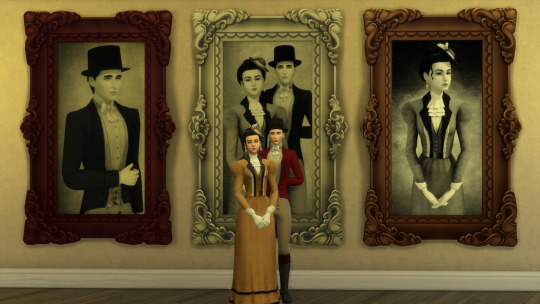
I'm having a lot of fun putting the Vatores in period clothes, so I made some renders of them dressed up in 1890s-1940s clothing and threw them into that big frame from Vampires.
download [sfs]
This was a pretty big project: 3 cc wall art pieces covering 6 decades of fashion with 12 separate outfits, which resulted in 18 individual renders and 144 total swatches. Also, the frame itself is huge. I prefer them sized down (shift + [ in buy mode) but they are 100% the type to own larger-than-life portraits of themselves.
My hc is that the Vatores were born in the late 1930s/early 1940s, so imo they aren't actually old enough to have worn any of these clothes when they were first in style. I think they dressed up like it’s old times and took a buncha pictures just to confuse people trying to figure out how old they really are. Sibling bonding!
Included below are all 18 renders, with cc and full color below the cut.
1890s

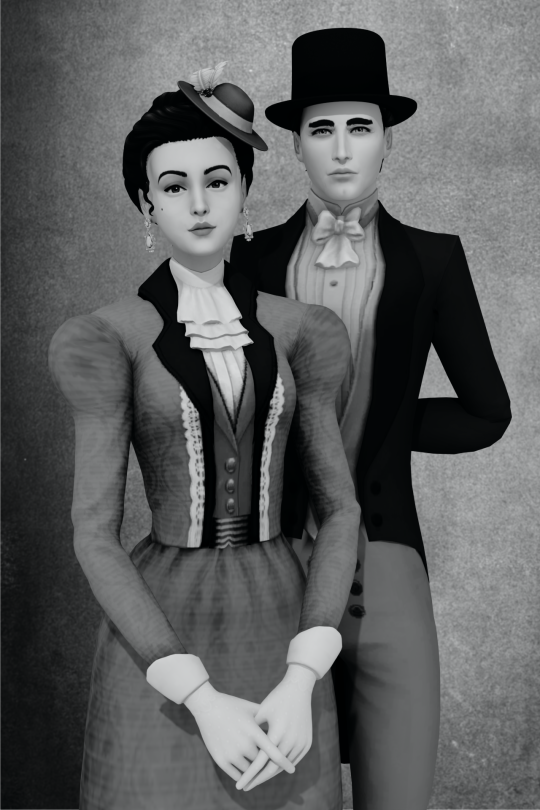
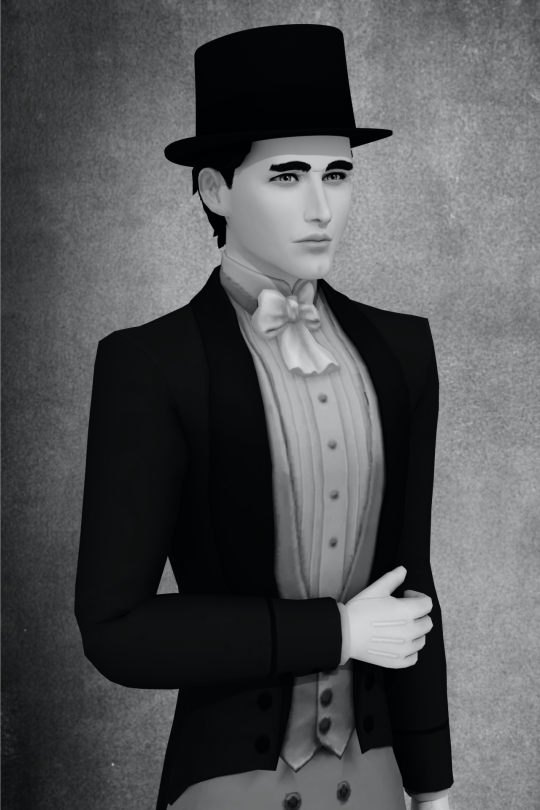
1900s
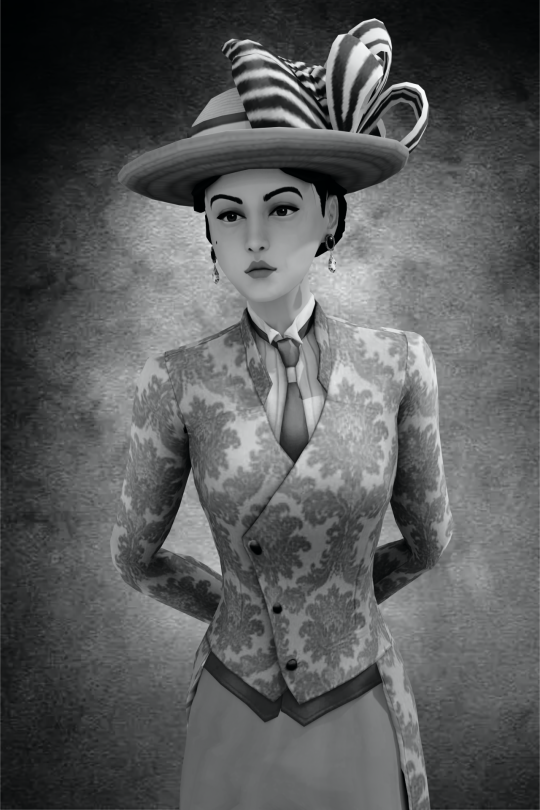


1910s

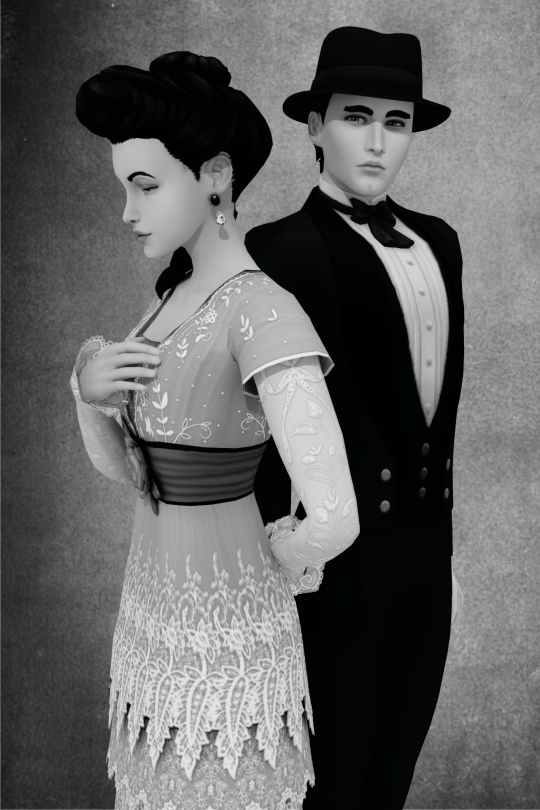
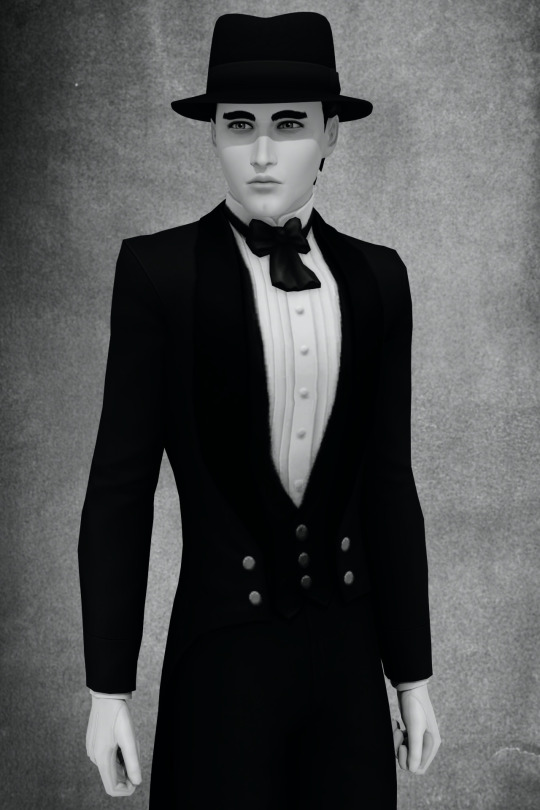
1920s
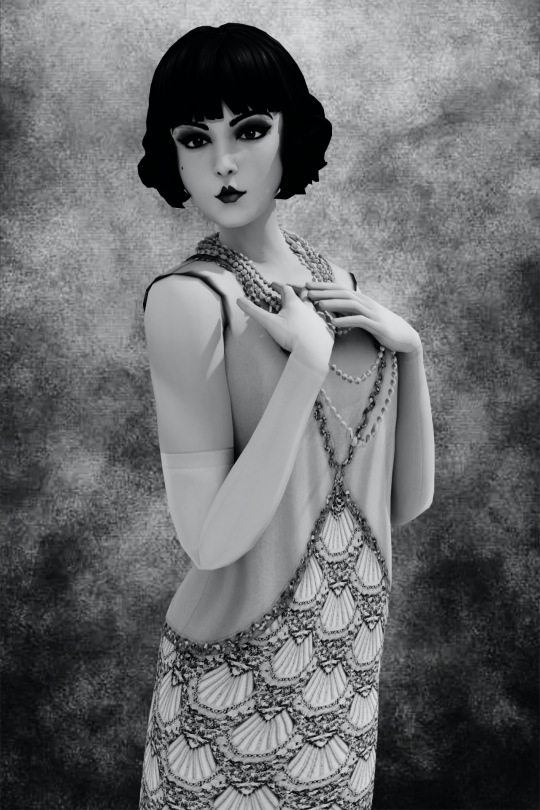

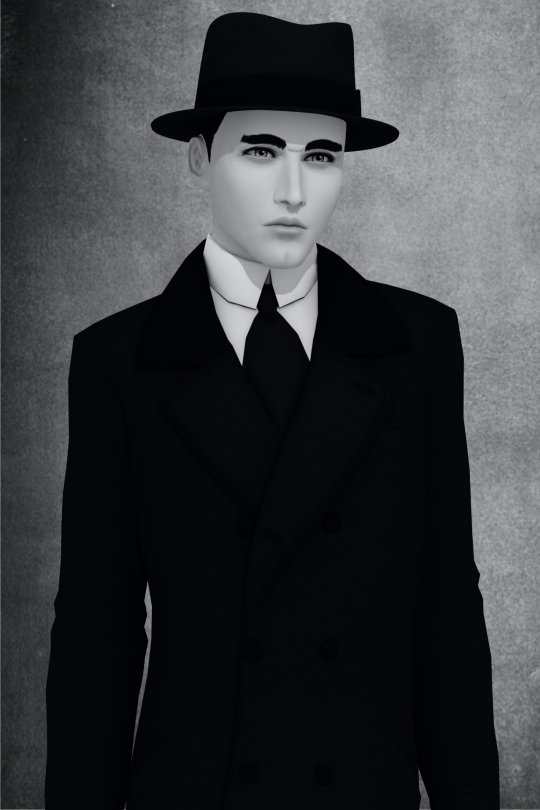
1930s
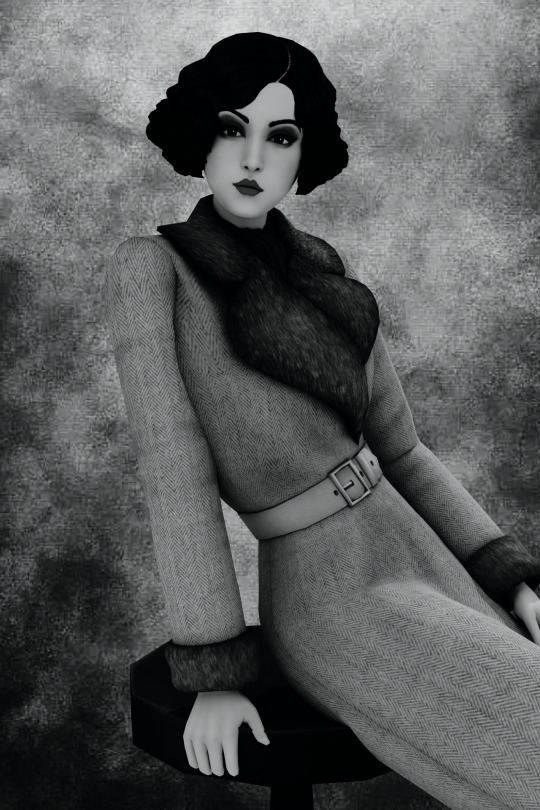
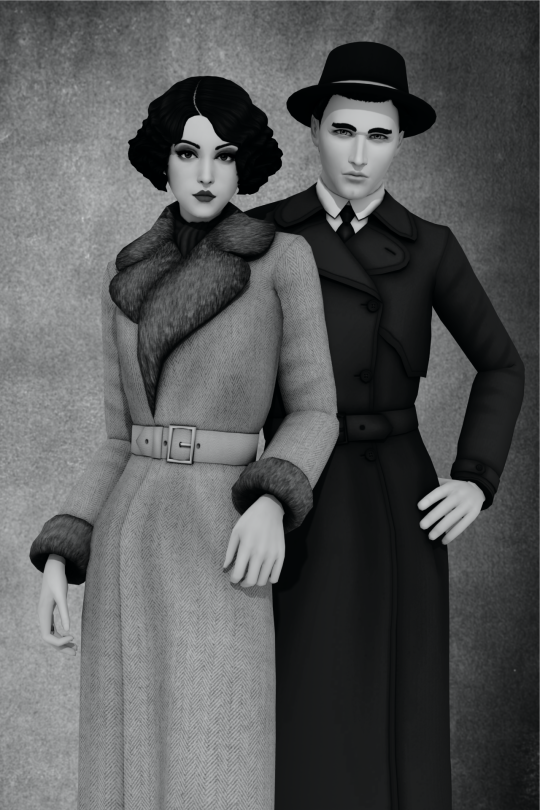
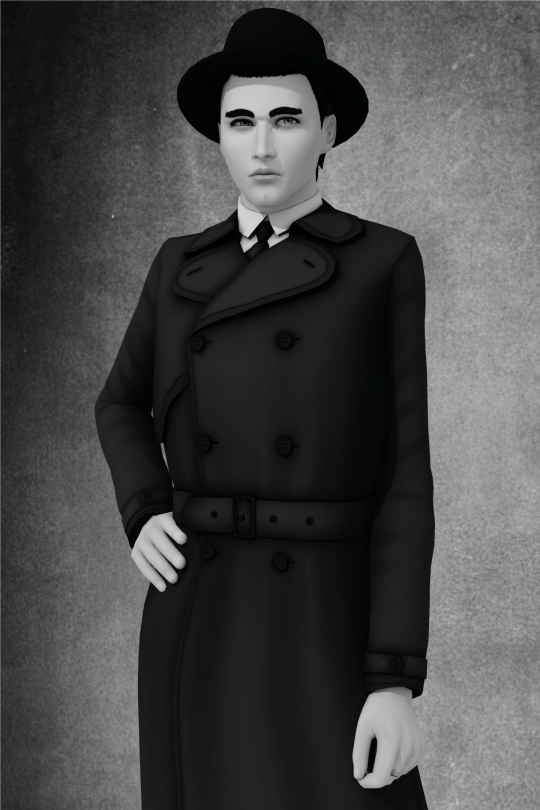
1940s

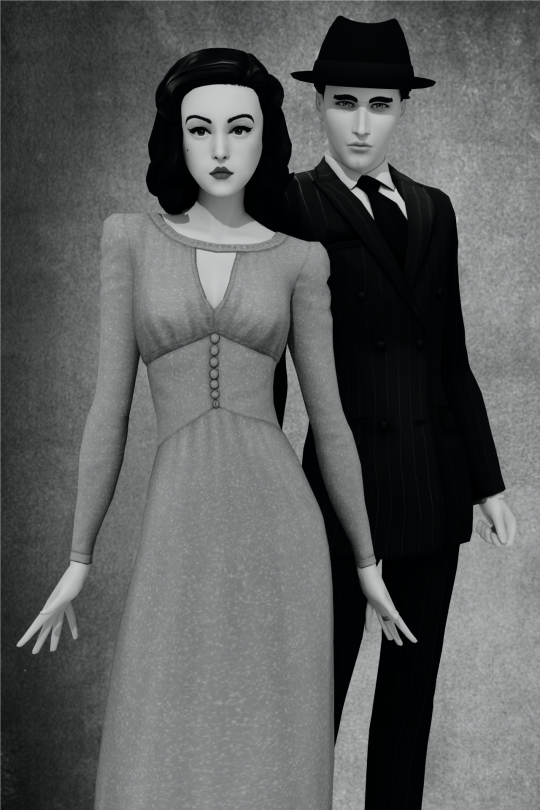
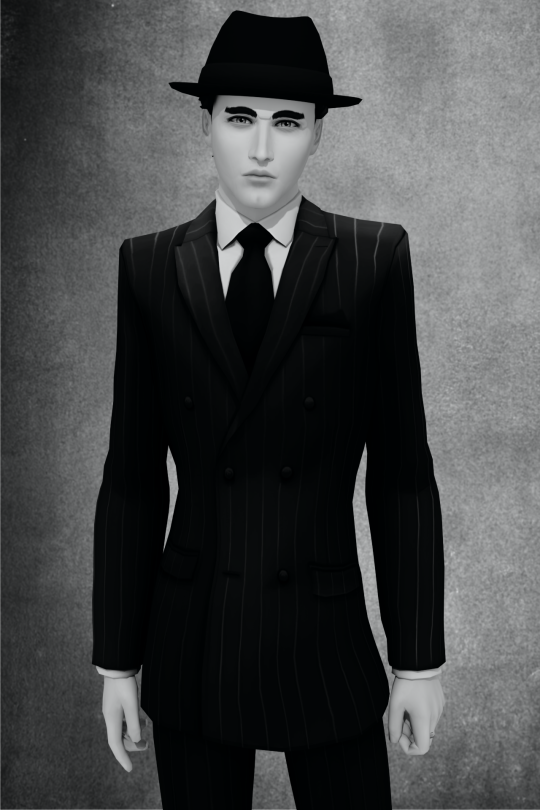
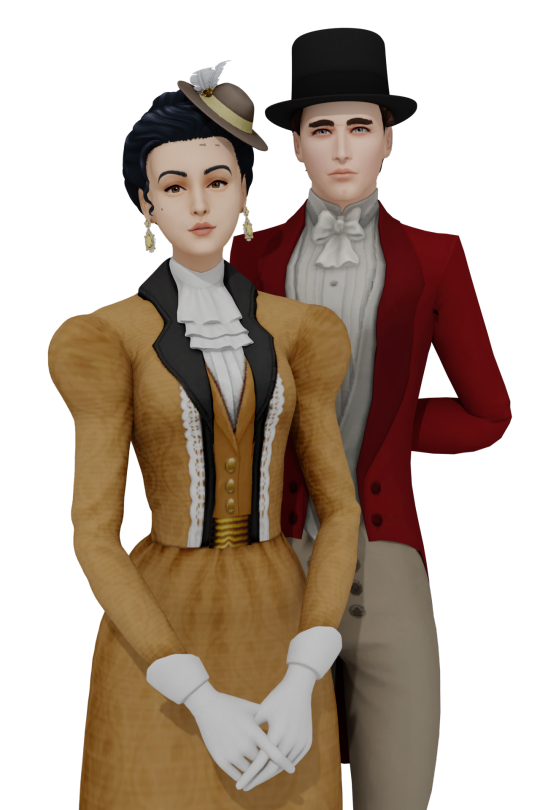

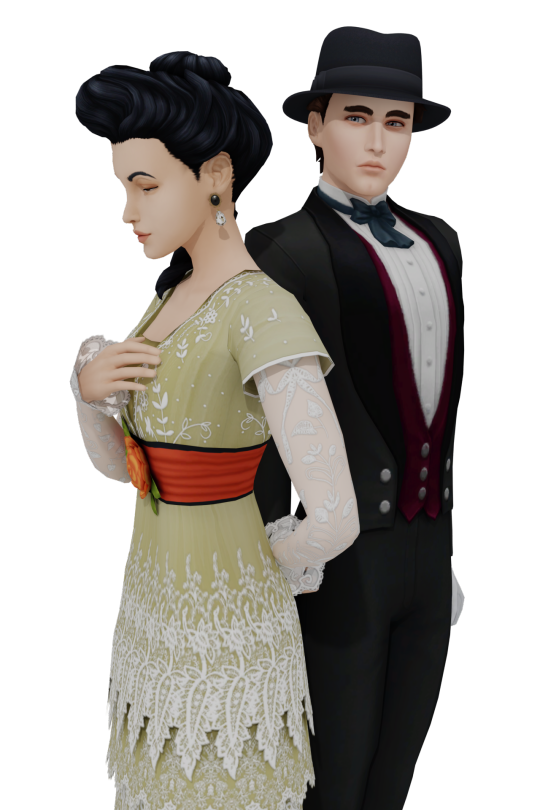


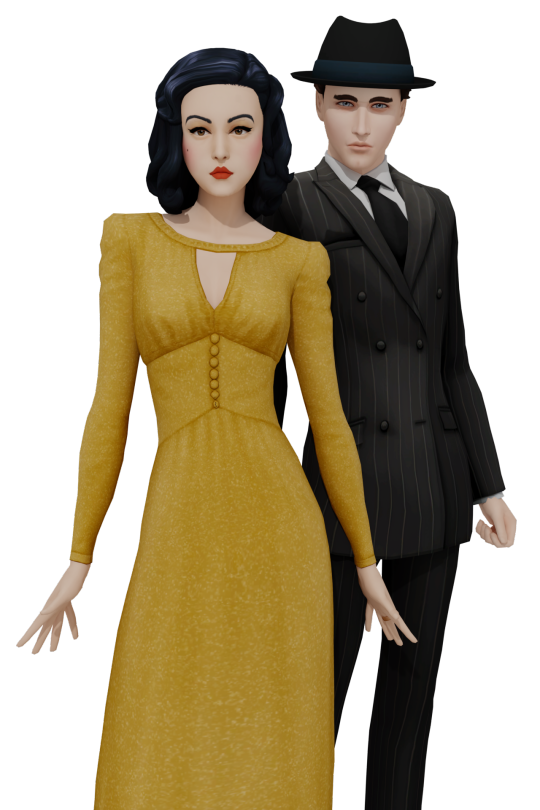
I'm a little obsessed with Lilith's 1940s look ngl
lilith
1890s
hair: granny bun by @saurusness
hat: fine feathered hat by @gilded-ghosts
earrings: rose in the garden earrings by @rustys-cc
dress: the ida dress by retro-pixels (direct link)
pose: from mademoiselle by @blackpanda-ts4
1900s
hat: striped bow hat by @lilis-palace
hair: bertha by @buzzardly28
earrings: arthur earrings by @yakfarm
outfit: dress: edwardian huntress dress by @elfdor
pose: also from mademoiselle
1910s
hair and flower accessory: gibson curl updo by @the-melancholy-maiden
earrings: arthur earrings by yakfarm
dress: rose lunch dress by @happylifesims
pose: also from mademoiselle
1920s
hair: maxie by @raindropsoncowplants
lipstick: clara by @chere-indolente
dress: 1920s evening dress 06 by happylifesims
pose: from the louise brooks posepack
1930s
hair: gigi by @simadelics
coat: 1930s female coat 02 by happylifesims
pose: from barstool poses ii by @katverse
1940s
hair & dress from forties film noir by gilded-ghosts
pose: from monday poses by @ratboysims
caleb
1890
hat: 1920s top hat by happylifesims
1900
outfit: men's casual edwardian suit by @historicalsimslife
hat: 1920s bowler hat by happylifesims
1910
hat: 1920s fedora hat by happylifesims
1920
hat/coat: dmitri hat & coat by happylifesims
1930
fedora shape no. 2 by happylifesims
1930s male trench coat 01 by happylifesims
1940
hat: fedora shape no. 1 by happylifesims
suit: paper, ink, & sorrow suit by @anachrosims
sibling poses
jane austen poses by @atashi77 (both 1890)
model poses 32 (lilith 1900, 1920, 1930, 1940) and male poses 11 (caleb 1900, 1910, 1920, 1930, 1940) by @helgatisha
edwardian socialite by @funkyllama (lilith 1910)
@occult-cc-finds
#lilith vatore#caleb vatore#ts4cc#ts4 cc#ts4 buy#ts4 lookbook#ts4 vampires#ts4 wall art#ts4 decor#ts4 historical#ts4 premades#dead-lights cc#deadit#ts4 victorian#ts4 edwardian
263 notes
·
View notes
Text

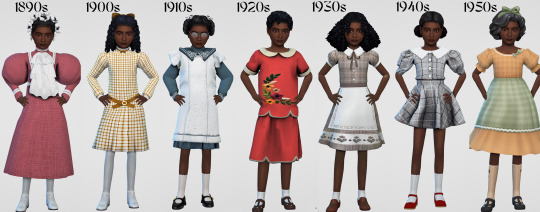
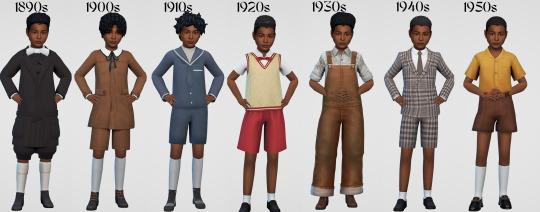

For much of human history, children were dressed similarly or identical to adults and this was true for the Victorian era which saw children dressed in stiff heavy layers that didn't allow for play. By the 1900s, in line with adult styles, children clothing became much less elaborate. Little girls emulated the elongated silhouette fashionable for adult women with drop waist dresses while boys' clothing became increasingly sailor inspired.
The 1910s established children's clothing as separate to adult styles. Sailor outfits were all the rage, particularly for young boys. WW1 meant rationing so hemlines crept up and clothing became less ornate in construction and embellishments.
After the war, in the 1920s, children's fashion remained simple, gone were the velvets and silk of the Victorians, instead sturdy textiles like cotton were used. Layering had also become a thing of the past, outfits were now often simple one pieces.
The Great depression occured in the 1930s and it left many families destitute. Children's clothing was handmade and sturdy fabrics like denim were favoured; "flour sack" dresses also became common place.
By the 1940s, many families had recovered from the depression but WW2 and rationing still meant that clothing had to be handmade with what was available. Many magazines at the time included simple patterns and any fabric was used even old curtains.
The 1950s are defined by the baby boom. Lots more children around increased demand for children's clothing and for a majority of families, life and finances improved after the war therefore they had money to spend. This lead to mass-manufacture of clothing using synthetic fibres..Young girls fashions were increasingly feminine:full skirt dresses,similar to their mothers, with bows and other hair accessories.
Boys' clothing became sturdier to allow for increased physical activity as the government of many countries began to mandate compulsory phys ed due to high levels of poor fitness exposed by the draft.
#sims 4 decades challenge#ts4 decades challenge#sims 4 simblr#resources#sims 4 lookbook#decades challenge cc#kids lookbook#tried to make this as accurate as I could 🤧#too much cc to link so feel free to send a wcif if there's something you'd like
205 notes
·
View notes
Text
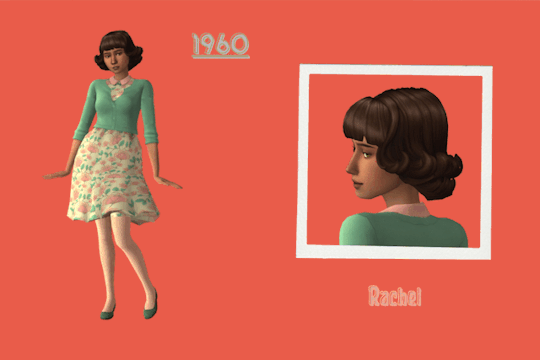
"I was pretending that I did not speak their language; on the moon we spoke a soft, liquid tongue, and sang in the starlight, looking down on the dead dried world." (We Have Always Lived In The Castle – Shirley Jackson, 1962)
the 1960s were also known as the swingin' sixties, and that name could not be more appropriate. while some other decades had moved towards comfort, the 1960's truly embraced it. some of the youth simply threw on a tunic and stepped into some pants and walked out the door! the popularity of television broadcasted different styles and trends across the country and the world. new materials like acrylics and polyesters were cheap to produce and to buy, and made fashion more accessible than it ever had been. the swingin' sixties brought the youth miniskirts, striped sweaters, the boxy "mod" look, and the bright, fun makeup associated with famous artists like twiggy. some older women tended towards the skirt + suit jacket combination worn by first lady jackie kennedy, but the comfort of the youth was appealing to all ages. beatnik fashion was also popular, with trim black trousers and dark sweaters. in 1964, hairspray was the most popular beauty product on the market – and it showed in the elaborate updos of the era. as the decade drew to a close, the "hippie" style was a popular look among the youth, with loose fitting tops and baggy pants, as well as maxi skirts. many of the hippies incorporated crafts into their fashion, with patchwork and beadings becoming popular.
this is only a very brief summary – the trends and influences of the 1960s are vast and complex, just as the 1960s themselves were. the social revolutions mirrored the revolutions in fashion, and i could write essays about it. but i am tired and i moved in today.
1800’s / 1900-1909 / 1910-1919 / 1920-1929 / 1930-1939 / 1940-1949 / 1950-1959
cc links under the cut!!
see my resources page for genetics
rachel : birksche's pam hair / fuckyeahunbichobolita's valentines dress / laundry day socks / renorasims' not so flat flats
remington : cats and dogs hair / dissia's retro fur coat accessory (tsr download) / get famous outfit / discover university socks / linzlu's 1960's shoes (download here)
rhiannon : buzzardly28's linda hair / needleworkreve's 1960s eyeshadow / gilded-ghosts' simply sweet dress / blueraptorsden’s vintage stockings / paranormal shoes
river : jools-simming's deborah beret / simadelics' curtain call hair / cottage living sweater / linzlu's 1960's pants (download here) / base game stockings / get together loafers
rjúpa : historysims4's 1960's coiffure / needleworkreve's 1960s eyeshadow / nords' retro reboot 60's hoop earrings (tsr downloads) / dzifasims' daisy dress / base game stockings / linzlu's 1960's shoes (download here)
roxanne : simduction's karen hair (updated by cyclopfrog) / fukkiemon's star pin / georgiapeachsims' mod madness makeup / get together outfit / base game bracelets / renorasims' leather wedge boots
ruslana : ravensim's terri hair / needleworkreve's 1960s eyeshadow / cottage living earrings / happylifesims' short one piece with scarf / get famous socks / serenity-cc's back to the sixties shoes
r'veena : kismet-sims' rosemary hair / needleworkreve's 1960s eyeshadow / get famous earrings / mysteriousoo's bright pants + tunic set (tsr download) / jius-sims' flower mary jane pumps
ryan : simduction's twiggy hair (updated by cyclopfrog) / needleworkreve's 1960s eyeshadow / liliili-sims' earrings #19 / marsmerizing-sims' lesley sweater / linzlu's 1960's skirt (download here) / base game stockings / cottage living lace-up heels
rzenia : marsosims' hita hair / brianitesims' nicks sunglasses / paranormal top / huiernxoxo's roxy pants / jius-sims' retro flower boots
thank you to @birksche @fuckyeahunbichobolita @renorasims @dissiasims @linzlu @buzzardly28 @needleworkreve @gilded-ghosts @blueraptorsden @jools-simming @simadelics @historysims4 @nords-sims @dzifasims @simduction @fukkiemon @georgiapeachsims @ravensim @happylifesimsreblogs @serenity-cc @kismet-sims @jius-sims @marsmerizing-sims @marsosims and @huiernxoxo !!
#my sims#sims 4 lookbook#ts4 lookbook#ts4lookbook#sims 4 retro lookbook#ts4 retro lookbook#sims 4 1960s lookbook#ts4 1960s lookbook#223 years#historical#1960s
192 notes
·
View notes
Text
I find it interesting to think that Miss Peregrine wore clothes according to the decades she lived in, in 1930 she wore 1930 fashion, She only adopted the Victorian style of clothing after creating her loop, because wearing these clothes in the wrong decade would draw too much attention, and she needed to blend in with the crowd.
My headcanon is that she always liked Victorian fashion, so when she created her loop in 1940 she started to dress however she wanted, after all it no longer mattered if she attracted attention or not. She was well established and isolated from the normals.
Alma was probably born very close to the beginning of 1900, since in 1907 she hadn't even established herself as Ymbryne yet, she was either a teenager or a young adult when the incident in Siberia happened. She lived in the academy loop, but needed to age outside of it, so she really was young, it doesn't make sense to think she was born before the creation of Miss A's loop.
Yes, if you calculate correctly, Miss Peregrine is apparently younger in real age than Hugh and Fiona.
51 notes
·
View notes
Text

"HOW ONE PAIR OF RRL DENIM JEANS MAKES IT FROM A COTTON FIELD TO YOUR CLOSET" - by Ikhtier Rustamov
When Ralph Lauren founded Double RL in 1993, he was inspired by the heritage of the American West and the train-hopping, steer-wrangling, gold-panning men who helped to settle it. “It’s not fashion, it’s real stuff,” Ralph has been known to say about the line in the years since. Nothing better embodies that uniquely American quality than a pair of blue jeans (made in the first place for the hard-wearing needs of miners and cowboys). American made jeans have always been a staple in the Double RL wardrobe, but the jeans made with the “East-West” denim, which crosses the globe in pursuit of perfection, just may be the gold standard. Here’s how a single pair comes together.
All denim is made from cotton, but not all cotton is created equal: the material can vary vastly in quality depending on where it’s sourced. RRL’s East-West denim is fabricated using premium grade cotton harvested in the state of Tennessee. The crop that grows there is renowned for its extra long, uneven fibers. When eventually spun and woven, that will translate into denim that’s supremely resilient, with a unique texture that sets it apart from the pack.
From Tennessee, the cotton is flown across the ocean to Japan. To Okayama, specifically, a city that is to denim what Memphis is to the blues. Today, some of the world’s best American denim is made in Japan, where a centuries-old tradition for indigo-dying and fabric weaving is combined with a dedication to maintaining and using vintage narrow shuttle looms which were largely dispensed with half a century ago. In the 1900s, all denim was made on these narrow shuttle looms: slow, noisy, and costly to maintain these looms created a narrow fabric with low-tension, resulting in strong and dynamic denim, rich in texture and finished on either end with a closed selvedge edge. By the 1950s, the fabric had grown so popular that most factories switched to more efficient air-jet looms, creating more product, faster, cheaper and at a lower quality.
To create our East-West denim, we partnered with a small Okayama denim mill that is a standard-bearer in a nearly lost art. The long-staple cotton is deftly ring-spun into a soft, lofty yarn, and rope dyed a red-blue shade of indigo inspired by jeans from the 1930s. Spun and dyed, the yarn is finally woven into bolts of fabric on wooden hanger-style shuttle looms, finished with an iconic red-line of yarn through the selvedge fabric edges. Off the loom, the fabric is then Sanforized, to reduce shrinkage, and finished with a proprietary process that retains the natural “loomstate” characteristics of the denim, creating a true “hand of quality”.
From one denim mecca to the next, the finished bolts are shipped over to California — the state where jeans got their start. Here the product really takes shape: the denim is cut and sewn into finished jeans manually using methods that were common from the 1940s-1960s, but have become rare today: chain-stitching, washer burrs, hidden rivets, and handset pockets and waistbands.
American-made thread and rivets hold it all together, while an open “busted” outseam on the outside of each pant leg leaves the selvedge edge visible as a hallmark of quality. For a finishing touch, the signature RRL leather patch is applied by hand.
Once assembled, the jeans are given a final once-over for detailing and distressing. A team of artisans in Los Angeles fits each individual pair onto a special form and rough them up just a bit. Hand-sanding is one of the best ways to give a patina of age, but that’s just one piece of the tool-kit: a finished pair of pants can undergo up to 50 steps before they head out the door, and that’s without even considering the variety of vintage-inspired washes that change with every season.
With this last step, East-West Denim goes from uniform fabric to a wear-ready pair of RRL jeans.
From field to factory to weekly rotation, East-West Denim comes to life when the jeans take on the life of the wearer, weathered by the elements and the inevitable abrasions that come from daily use. Eventually, whiskers above the legs and “honeycombs” behind the knees appear. The tell-tale “track” on the outer inseam manifests. A phantom outline appears on the pocket where you always put your wallet. And then they’re not just “real stuff.” They’re really yours.
22 notes
·
View notes
Text
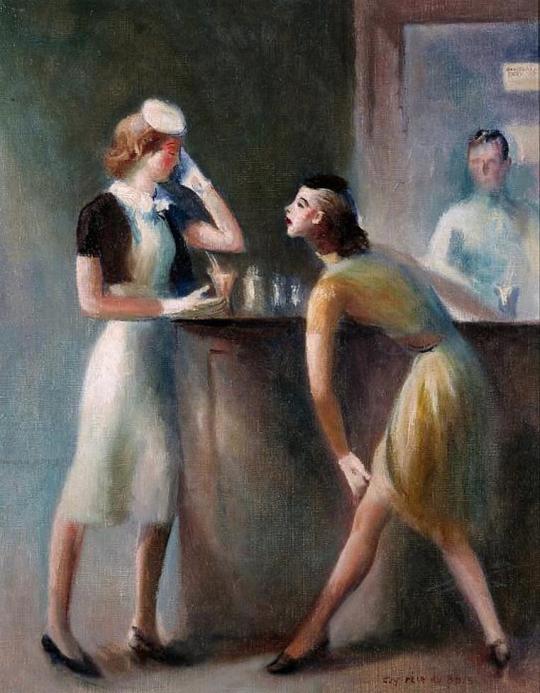
MWW Artwork of the Day (11/10/23) Guy Pène du Bois (American, 1884-1958) At the Soda Fountain (c. 1930) Oil on canvas, 50.2 x 38.7 cm. The Boca Raton (LA) Museum of Art (Gift of Jane & Jay Braus)
American Realist painter Guy Pène du Bois’ main focus was on the fashion and "manners of his time" middle and upper-class of the early 1900s through the 1940s. His style was dominated by stylized figures. Even with three figures making up "At the Soda Fountain," there is a palpable feeling of detachment and visual tension, similar to the dramatic pause in a play or a movie. The soda fountain server is definitively isolated behind the bar and to the back; the women are engaged but standing awkwardly as one has her eyes closed as she brings her hand to the side of her face (Is she fixing her hat?) and the other gracefully bends slightly from the waist (To adjust her stockings or dress?) and looks directly into the other’s closed eyes.
16 notes
·
View notes
Text














Wear a Dress Day
Wear a Dress Day is celebrated every June 1 and gives women an opportunity to sport their favorite dress. This includes dresses of all sorts, designs, and patterns — all that is important is that it’s a dress you love. Why create a day that is all about dresses, you ask? Well, the fact is, dresses are easy to wear and super comfy, especially in the hot summer weather when you begin to sweat the minute you step out of an air-conditioned space. So use this occasion to dump your jeans and adorn a cute dress that makes you look oh so lovely.
History of Wear a Dress Day
Amongst various interesting days celebrated across the U.S., one fun occasion is Wear a Dress Day. Dedicated to all women — or basically anyone who wants to wear a dress — the day is all about dressing up and having fun! The origins of the day are unclear but what we do know is, its observation started in 2010 and led to many women taking photos of themselves in dresses and posting them on social media with the hashtag #WearADressDay.
The question is, why are dresses so important to the ladies? Well, this is mostly because there is a long history of how dresses evolved over time and not all were the most comfortable. For instance, from the 16th century till the 19th century, dresses were often worn with uncomfortable corsets that made it hard for women to even breathe. While the dresses looked gorgeous, they were also extremely uncomfortable to wear since they were created out of various layers of heavy fabrics. In 1775, the dresses got bigger and fancier, making it tough for women to move around with ease.
It wasn’t until 1860 when the dress fabric became simpler and easier to wear, but the size of dresses only began to decrease in the 1900s. By the 1920s, the hemlines began to reduce and dresses became more enjoyable to wear. Today, women can wear short dresses, loose dresses, tight dresses, or full-length gowns without worrying about rigid social norms — and it’s this empowerment that makes us want to celebrate Wear a Dress Day!
Wear a Dress Day timeline
1800s The Big Ones
Hoop-skirt style dresses are worn.
1940s Shrinking Dresses
Dress hemlines are reduced to save money and cloth during World War II.
1947T he Hour Glass Look
Christian Dior introduces dresses that highlight a woman’s figure.
1960s Short Skirts
The mini dress becomes fashionable.
How to Celebrate Wear a Dress Day
Throw a party of your favorite era
Donate some dresses
Wear your best dress!
This means you have endless options, ranging from the ’60s to the funky ’90s. The aim is to use the opportunity to wear one of your favorite dresses in public.
Since everyone loves dresses, use this day to donate some of the dresses you no longer wear to charity.
Pick out your favorite dress from your wardrobe and make a plan with friends so you can wear it out. Whether it's a party dress or a cute skater dress, anything that makes you look and feel good will work.
5 Fun Facts About Dresses
The longest wedding dress
Young Michael Kors
Marilyn Monroe’s expensive dress
The 19th-century black dress
The ‘little black dress’
The longest wedding dress has a 1.85-mile-long train.
The first dress that designer Michael Kors worked on was his mother’s wedding dress.
The actress owned a dress with 6,000 rhinestones.
The black dress was worn solely to mourn a death.
The little black dress was compared to the Ford car due to its practicality.
Why Dresses Are Important
They are easy to wear
Dresses make a style statement
What you wear affects your psychology
Short dresses and maxis are super easy to wear, they are comfortable, affordable, and make you feel powerful and feminine. Short dresses are also more desirable for ladies residing in countries with a hot climate.
While everyone likes to suit up once in a while, the variety of dress designs available make it easy for you to make a style statement — even on a low budget!
The ‘little black dress,’ for instance, has become an essence of femininity, and women sporting this color often feel more confident and sure of themselves.
Source
#Brix Restaurant & Gardens#I'll be back this summer#Chicago#travel#USA#original photography#MS Allure of the Seas#outdoors#indoors#vacation#tourist attraction#Lincoln Park#parking lot#rental car#landmark#skyline#architecture#cityscape#Wear a Dress Day#WearADressDay#1 June
2 notes
·
View notes
Text
‘Baking Yesteryear’ cookbook takes a stroll down memory lane
Check out my latest column

Christmas Crack, from the 1970s chapter, is a confection that longs to sit patiently in a glass jar, eager to offer yet another reason for joy during the season. Dylan indulges here. (Courtesy of Lauren Jones)
‘Tis the season for indulging in our favorite foods, especially decadent desserts, and confections. It’s the time families gather in the kitchen baking their favorite recipes, many handed down through the generations.
These vintage recipes, often written on index cards, tattered and stained from years of use, provoke warm memories of baking with loved ones when we were young. What better way to embrace the season and bring warmth, nostalgia, joy and togetherness to a home. Holiday baking brings back fond memories of simpler and calmer times. It is an escape as well as a connection to the past.
One of the top cookbook titles this year is “Baking Yesteryear: The Best Recipes from the 1900’s to the 1980’s,” by B. Dylan Hollis (2023, DK, a division of Penguin Random House LLC, $32). Hollis’ book will take you down memory lane. The chapters are broken down by decade, beginning with the 1900s and ending with the 1980s.
Hollis shares his favorites from each decade.
1900s: Food for the Gods
1910s: Chocolate Potato Cake
1920s: Ricciarelli
1930s: Whipped Cream Cake
1940s: Applesauce Graham Cracker Torte
1950s: Kiskadee Fantasy
1960s: Haystacks
1970s: Christmas Crack
1980s: The Buster
The final chapter “Worst of the Worst,” is where he writes, “these creations are the kind that make you ponder the sobriety of the recipe developer.” You might be thinking, why were these recipes included? He writes, “I resolved to do so, since the bad experiences of what I do play such a big part in my overall journey of exploring cooking past, and not including them would ignore the fact that some bona fide, published recipes are simply bad — horrendous bad.”
So, what are a few of the recipes included here? Pickle Cheesecake, jellied meatloaf and SpaghettiOs Jell-O Ring (watch these videos at your own risk! https://bit.ly/3Np0cY6 https://bit.ly/48dPage). If you are a fan of these recipes, don’t fret, food is personal, like fashion.
The headnotes to each recipe are intriguing … some history with a good measure of humor as you will see in the recipes shared below.
I had the opportunity to interview Hollis, a larger-than-life personality. The conversation could have gone on and on. Both of us share an interest in vintage cookbooks. I asked how his delight in vintage recipes came about. From a career as a jazz pianist, I thought it was quite a diversion to becoming a baker. Well, he is not just a baker, he is a social media phenomenon with millions of followers patiently (or perhaps impatiently) waiting for his next video showcasing his unique style and humor while cooking. He said it was happenstance.
“During the pandemic I had too much time on my hands and the quarantine caused boredom,” he said.
Hollis always collected old things, including vintage cookbooks. They came in handy to fill the time. One day he looked through a 1912 Canadian cookbook and came across a recipe for pork cake.
“I just stared at it,” he said.
His experiment making the cake on video went viral and the rest is history.
Perhaps these recipes will become part of your holiday repertoire. As Hollis writes in the conclusion of his book, “The experience of putting together Baking Yesterday for you was a pleasure unmatched. Not only as an opportunity to breathe new life into dishes that once held the hearts of those in the old world, but as a celebration of the fact that while the cakes might change, the joys of baking remain timeless. … I sincerely hope that Baking Yesteryear serves you well, and offers you the opportunity to taste just a sliver of the past’s ingenuity, and the magic that I feel comes with it.”
Until my next column, Happy Baking and Happy Holidays!
For the recipe for Potato Chip Cookies from the 1970s visit stephenfries.com/recipes.
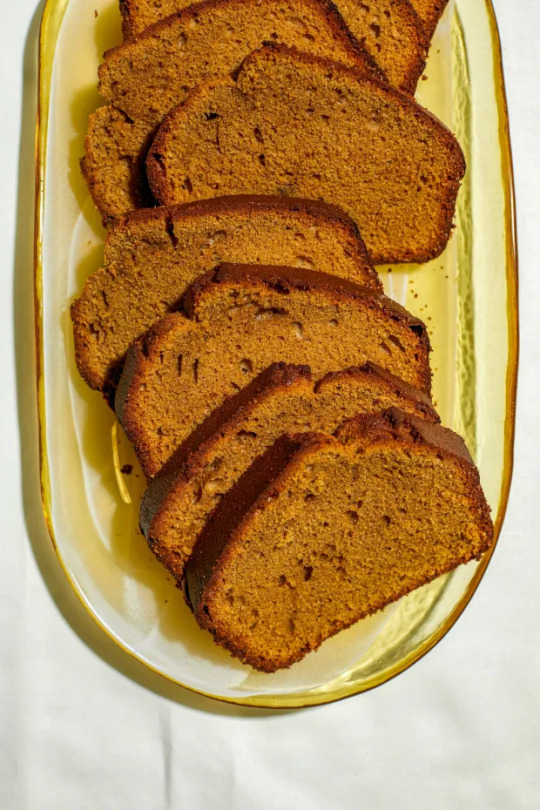
Admiral’s Gingerbread, from the 1910s, is a surprisingly soft, light, and buttery ginger loaf, setting itself apart from traditional dense, dark gingerbreads of yuletide. (Courtesy of Kelley Jordan-Schuyler)
Admiral’s Gingerbread (1910s chapter)
The headnote says, “This is a most peculiar variety of gingerbread, and its bizarre method of preparation seems to have been quite popular along the East Coast cities of the United States in the early 1910s under names like New York Gingerbread and Providence Gingerbread. Bakers will notice that it has an impressively backwards order of operation, but despite this (or because of it), the result is surprisingly soft, light, and buttery ginger loaf, setting itself apart from traditional dense, dark gingerbreads of yuletide.”
9 x 5-inch loaf quick bread
1 cup (225g) butter, softened
1½ cups (210g) all-purpose flour
2 tablespoons ground ginger
3 tablespoons molasses or treacle
Yolks of 5 large eggs, reserve whites
½ teaspoon salt
1½ cups (180g) powdered sugar
1 teaspoon baking powder
Preheat the oven to 350 degrees. Grease a 9×5-inch loaf pan.
In a large bowl, beat the butter until smooth and light. Gradually beat in the flour, ginger, and molasses. Beat until smooth. In a separate bowl, whisk together the egg yolks and the salt. Gradually whisk in the powdered sugar.
In the bowl of a stand mixer fitted with a whisk attachment, or in a large bowl with which an electric hand mixer is to be used, beat the reserved egg whites to stiff peaks. Beat in the baking powder.
Mix the egg yolk mixture into the creamed mixture, before adding the egg white mixture. Beat thoroughly.
Turn into the prepared pan and bake for 50 to 55 minutes, or until a toothpick inserted into the center can be removed cleanly.
Cool in the pan for 10 minutes before transferring to a wire rack to cool completely before slicing.
Christmas Crack (1970s chapter)
The headnote says, “I’ve never before beheld such a perfect meeting of caramel, chocolate, and salty crunch as I did the day I made Christmas Crack. I remember it vividly and has since become my #1 homemade candy. Beginning this recipe by counting and arranging soda crackers in a grid may seem unorthodox, but since the 1970s the making of crack has become a popular yuletide activity for families in the United States…And, just as stockings and candle-glow punctuate the quiet midwinter home, Christmas Crack longs to sit patiently in a glass jar, eager to offer yet another reason for joy during the season.”
40 saltine crackers
1 cup (225g) butter, softened
1 cup (220g) packed light brown sugar
2 cups (340g) semisweet, or milk chocolate chips (one 12oz bag)
Chopped nuts, peppermint candy pieces, M&M’s candies, chocolate bar pieces, or sprinkles, for topping
Preheat the oven to 350 degrees.
Line a large baking sheet with heavy-duty aluminum foil. Arrange a grid of saltine crackers in five rows of eight on the baking sheet. The crackers should all be touching.
Vertically crease the sides of the aluminum foil to create a dam that borders the crackers. In a medium saucepan over high heat, combine the butter and the brown sugar, stirring occasionally until it reaches a boil.
Once the mixture reaches a full boil, boil for 5 minutes without stirring.
Carefully pour the mixture evenly over the saltine crackers. The foil dam will prevent the syrup from spilling .Immediately bake for 7 minutes.
Remove from the oven and quickly sprinkle the chocolate chips evenly over the hot crackers. Allow to sit for 2 minutes, or until the chips appear glossy, indicating they have melted.
Carefully spread the melted chips in a thin, even layer over the crackers.
While the chocolate is still hot, sprinkle on any desired toppings. Chopped walnuts or green and red sprinkles are my favorite options to use.
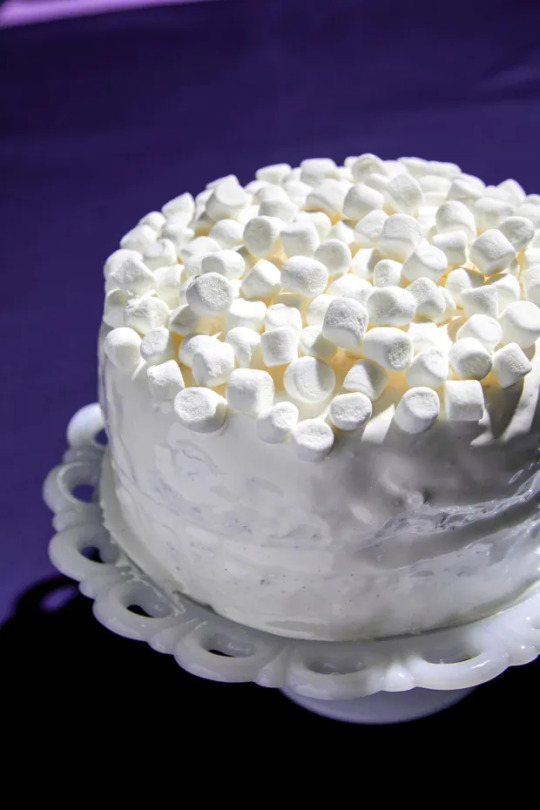
Midnight Mallowmalt Cake from the 1960s has a deep chocolate, marshmallow sweetness, and hints of malt and sour cream tartness. With a snowy blanket of marshmallows and boiled frosting, it is a winner if there’s ever been one. (Courtesy of Kelley Jordan-Schuyler)
Midnight Mallowmalt Cake (1960s chapter)
Makes two 9-inch layers
The headnote says, “Chocolate cakes are an entire world waiting to be explored, and this 1960s example is just as badass as its name. With deep chocolate, marshmallow sweetness, and hints of malt and sour cream tartness, all needed a snowy blanket of marshmallows and boiled frosting, it is a winner if there’s ever been one.”
CAKE
18 marshmallows, or 2 1/3 cups mini marshmallows (¼ lb, 113g)
4 ounces (113g) bittersweet chocolate
¾ cup (180ml) boiling water
3 large eggs
1¼ cups (250g) granulated sugar
2 teaspoons vanilla extract
1½ cups (375g) sour cream
2¼ cups (350g) all-purpose flour
¼ cup (36g) malted milk powder
1½ teaspoon baking soda
1 teaspoon salt
FROSTING
Whites of 2 large eggs
¾ cup (150g) granulated sugar
1⁄3 cup (80ml) light corn syrup
1 tablespoon white vinegar
1 teaspoon vanilla extract
Mini marshmallows, for garnish
Cake Method
Preheat the oven to 350 degrees. Grease two 9-inch cake pans.
Melt together the marshmallows and the chocolate in a double boiler.
Add in the boiling water and beat the mixture smooth. Remove from heat and allow to cool.
In a large bowl, beat together the eggs, sugar, and vanilla until thick and foamy. Blend in the sour cream and the cooled chocolate mixture.
In a separate bowl, combine the flour, malted milk powder, baking soda, and salt. Gradually add to the wet ingredients. Mix until well combined.
Turn into the prepared pans and bake for 25 to 30 minutes, or until a toothpick inserted into the center can be removed cleanly. Cool in the pans for 10 minutes before transferring to a wire rack to cool completely.
Frosting Method
In a large bowl that can be placed atop a double boiler, combine the egg whites, sugar, corn syrup, and vinegar.
Over boiling water, beat the mixture with an electric hand mixer until it thickens and soft peaks form. Remove from heat and beat in the vanilla.
Away from the heat, continue beating until the frosting has cooled and is thick enough to spread onto the cake. This will take some time, about 5 to 6 minutes.
Spread a suitable amount of frosting evenly atop the first cake. Invert the second cake atop the filling to form the second layer.
Frost the assembled cake with the remaining frosting. Decorate the top of the cake with marshmallows.
Recipes excerpted from “Baking Yesteryear,” reprinted by permission of DK, a division of Penguin Random House LLC. Copyright © 2023 by B. Dylan Hollis.)

Stephen Fries, is Professor Emeritus and former coordinator of the Hospitality Management Programs at Gateway Community College, in New Haven, Conn. He has been a food and culinary travel columnist for the past 15 years and is co-founder of and host of “Worth Tasting,” a culinary walking tour of downtown New Haven. He is a board member of the International Association of Culinary Professionals. Email him at [email protected]. For more, go to stephenfries.com.
3 notes
·
View notes
Text
When is ‘Cinderella’ set, anyway?
An unnecessary fashion history dissection of the 1950 Disney film
There are two large obstacles in the way of identifying a particular year.
The first, of course, is that the studio was not particularly concerned with setting the film in a specific year (and in fact had some incentive not to, in order to make the story ‘more timeless’).
The second is that the dress designs, particularly for Cinderella’s enchanted ballgown, were based largely on what was considered fashionable in the late 1940s, when the movie was being made.
The clocktower cannot be used to conclusively date the film, as the oldest clocktower still functioning today dates back to at least 1386 (the St Andrew’s Tower in Chioggia, Italy), and the fashions of the movie appear to be based on fashions of the 1800s.
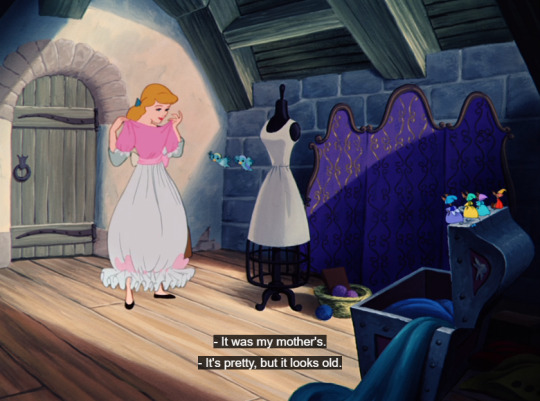
Cinderella’s mother’s dress confuses me, particularly the skirt and how it gathers at the bottom. It looks, to me, like there used to be an overskirt but the material for it has been repurposed, leaving only the underskirt. The puffed shoulders and rounded skirt (almost a bubble skirt), suggest that this silhouette was in fashion when her mother was a young woman and has come back into fashion in Cinderella’s adulthood, as we see sleeve puffs and dome skirts in many other dresses throughout the film.

Assuming we can use the sequels for clues, the story must occur after 1866. There is a sequence in the second movie where Cinderella wears a cage crinoline or ‘hoop skirt’, which was invented in 1856, while the third movie includes the waltz The Blue Danube (da-da-da-da-da, da-da, da-da) which was composed in 1866.
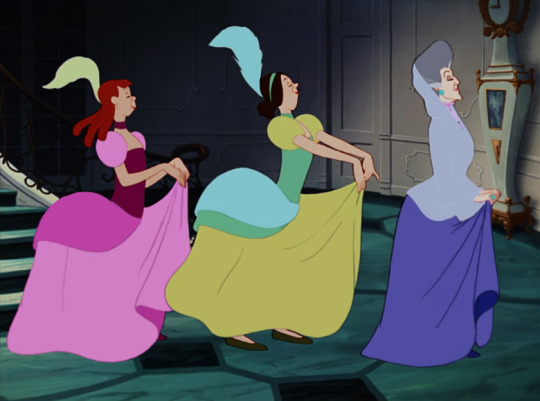
The stepsisters’ ballgowns appear to use shelf bustles, popular in the mid- to late-1880s.

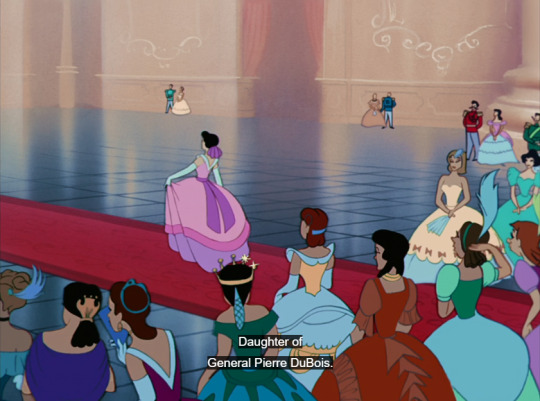
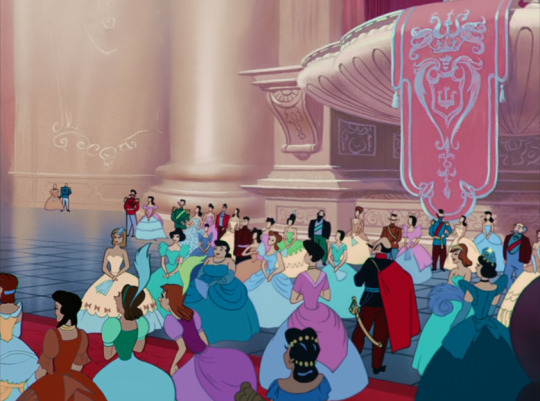


The guests at the ball wear a mix of dome skirts and bustle skirts, suggesting either that bustles are a new fashion or that Drizella and Anastasia’s dresses are slightly out of style.
Supporting the 'new fashion’ interpretation, dome skirts had their heyday in the 1850s and 1860s, prior to what historical costumers typically refer to as the bustle era. It is possible that the dome skirt silhouette has simply lingered in the fashions of the “tiny kingdom [...] rich in romance and tradition” wherein the story is set.
The 'out of style’ interpretation is supported by the dialogue just before the mice steal the sash and beads for Cinderella’s dress. Anastasia declares “I always end up in these old rags,” before throwing her sash to the floor. When the stepsisters are talking over one another while storming out of the room, one of Drizella’s lines that can be picked out is “I don’t see why I can’t have something new!”
Furthermore, part of the opening narration says, “The chateau fell into disrepair, for the family fortunes were squandered upon the vain and selfish stepsisters,” indicating that by the time the main story begins, they are starting to face financial trouble due to living beyond their means in the years before, and thus would not be able to keep up with the latest fashions.
Then there are the sleeves.
Sleeve puffs were popular in the 1830s and 1890s. Lady Tremaine’s regular dress in particular looks like something from 1892 (as the upper sleeves started to inflate) or 1897 (as the puffs were raised more deliberately above the elbow and started to deflate). Her dress for the ball has much more fitted sleeves, with just a slight puff at the shoulder, as one might see at the end of the 1890s or the first few years of the 1900s.
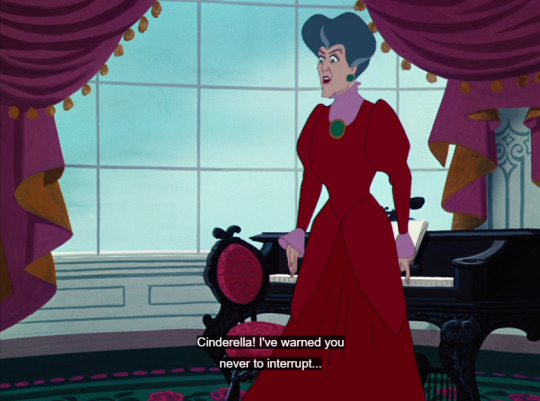

Anastasia and Drizella both wear short sleeves all the time, which were far more common in evening gowns than daily wear.
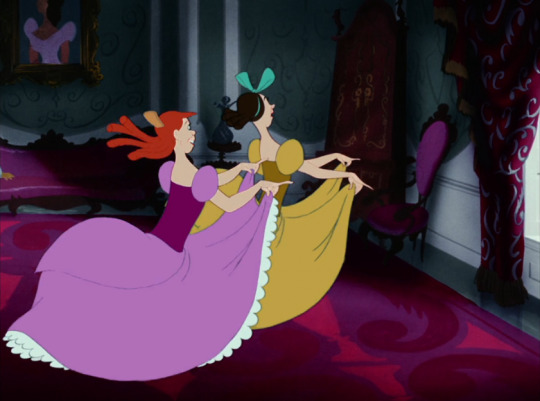
This could be seen as a comment on their vanity and pretentiousness, or as further evidence that the Tremaines are living beyond their means and wear their ‘best clothes’ all the time to conceal how few clothes they own.
The combination of sleeve puff and dome skirt looks like it takes influence from 1830s fashion. The childhood sequence at the opening of the movie shows Cinderella and her stepsisters each wearing dome skirts, Cinderella in puffy sleeves and Drizella and Anastasia in short sleeves with lace cuffs.
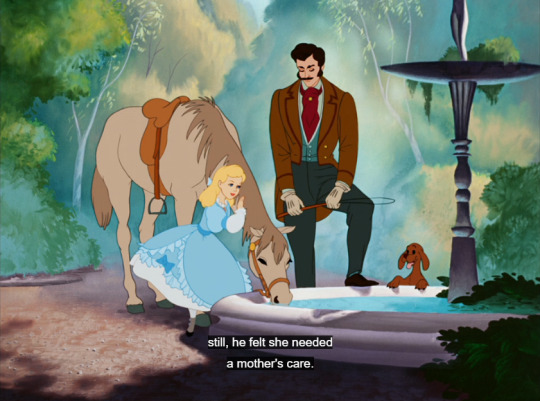
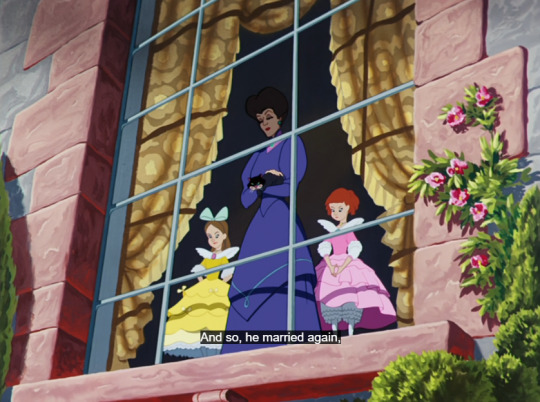
These look very 1830s to me, which implies that, if the bulk of the film is set in the 1860s, the three women are in their thirties or forties. This is in turn unlikely as, if this were the case, some comment would have been made about Anastasia and Drizella still being unmarried at that age. They are more likely to be in their twenties.
(Also, now that I know more about underpinnings, it’s so weird how Anastasia is visibly wearing zero petticoats in the childhood opening scene and yet her skirt still sticks out like that.)
If their childhood garb is in fact the dome skirts of the late 1860s, then the majority of the movie could be set in the 1880s, with the costumers throwing puffed sleeves on a little early. There should, in that time period, be considerably more trims and decoration embellishing each dress, and printed fabric was also fashionable at the time, but this can be explained as a limit of the medium - animators were still having to draw each film cell by hand, after all. This also makes it plausible for Cinderella’s mother’s dress, with its puff sleeves and odd skirt, to be from the 1830s, and perhaps having lost some pieces over time.
8 notes
·
View notes
Text

Vintage Flue Coverings:
You may never have a chimney or wall duct opening in your home that needs covering, so you won’t be in need of a decorative flue cover. But in the days when houses were heated with wood, oil or coal-stoves, heat carried up through brick or stone chimneys to the upper floors. Each room had a flue opening, but heating pipes were often removed in the spring and stored until fall, leaving openings (often unsightly) in the walls. Flue openings were covered to make rooms more attractive (and keep small animals and children’s toys out of the pipes).
Innumerable kinds of flue covers have been invented, but the usual ones for inside the house were decorative round metal or cardboard “plates” about 8” in diameter that would hang via a chain or hook over a flue opening. Different flue covers were used in different rooms, and over the years, styles varied along with fashions in clothing and furnishings.
In the Victorian era, flue openings were sometimes covered with wrought iron or brass grilles that could be left in place year around. In other homes, removable metal plates were used. These flue covers were dinner-plate sized, slightly convex, and often decorated. Some flue covers were hand-painted on the inside of round or oblong glass surfaces, but most had a printed picture applied under a thin glass layer with a cardboard backing. Many flue covers appear to modern eyes like upside-down paper plates with small pictures in the centers.
About the turn of the last century, shopkeepers discovered the value of building goodwill by means of inexpensive giveaways. Today, we receive calendars, yardsticks and coffee mugs, all of which tout some business by name. Before 1900, a cheerful picture was considered effective sales promotion although the giver’s name did not appear on the item. Advertising a business’s name on freebies was a later inspiration. Well into the 1940s in America, fanciful flue covers were given away in the thousands by doctors, dentists, shopkeepers, plumbers and so on.
Today, chimney flue covers are interesting wall decorations evocative of the past. Collectors of flue covers often specialize in a kind of subject matter, such as lovely ladies, small children, winter scenes, dogs or cats, and so on. One popular type, the hand-painted cover, usually features flowers. Early in the 20th century, ladies painted innumerable china teacups and dinner plates, mostly with flowers, and flue covers were another conveniently-sized painting surface. Other collectible flue covers are those commemorating a particular event or that have pictures of churches or public buildings.
Other collectors focus on the composition of the cover: Some were made of thin wood; others painted to look like wood. Still others have interesting pressed-metal edges. Whatever the subject matter, a group of five or a dozen with a single theme can make an unusual artistic wall display.
2 notes
·
View notes
Text
Sweatshirts: How they became the ultimate comfort clothing
Sweatshirts: How They Became the Ultimate Comfort Clothing
Sweatshirts, also known as hoodies or pullovers, have become a staple in every wardrobe. These comfortable and versatile garments have a rich history that dates back to the early 1900s. In this blog post, we will explore how sweatshirts evolved from being simple athletic wear to becoming the ultimate comfort clothing. If you want to buy Click Here .
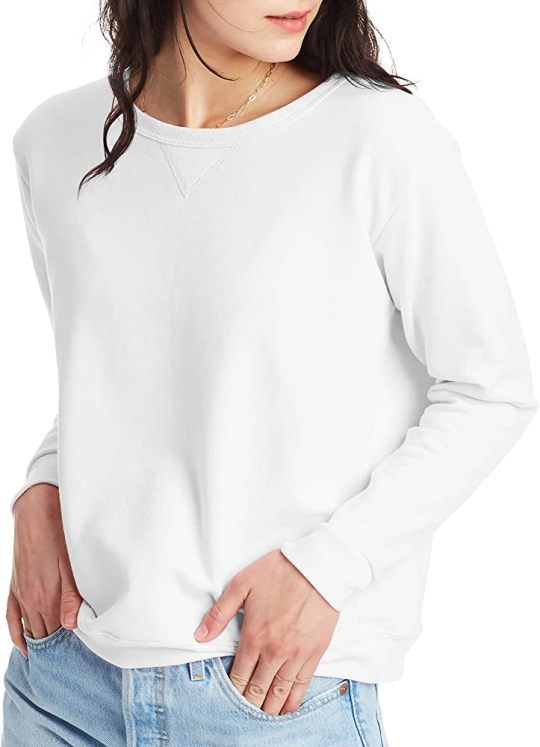
The Origin of Sweatshirts
The origins of the sweatshirt can be traced back to the early 1900s, when athletic teams would wear long-sleeved shirts made of heavy cotton fabric to keep them warm during practices and games. These shirts were referred to as "sweatshirts" because they would absorb the sweat of the athletes during intense physical activity.
The first sweatshirts were simple and functional, with no added embellishments or designs. They were made from heavy cotton fabric and featured a basic crew neck and long sleeves. These early sweatshirts were worn exclusively by athletes and were not seen as fashionable clothing.
The Evolution of Sweatshirts
As the decades passed, sweatshirts began to evolve in both design and function. In the 1930s and 1940s, sweatshirts were adopted by college students and became a popular casual wear. The sweatshirts of this era were made from lighter cotton and featured a variety of designs, such as school logos and mascots.
During the 1950s, sweatshirts became even more popular and began to be worn by people of all ages. They were still primarily made from cotton and were available in a variety of colors and designs. However, it was not until the 1960s and 1970s that sweatshirts truly became a fashion statement.
In the 1960s and 1970s, sweatshirts were embraced by the counterculture and became a symbol of rebellion and nonconformity. These sweatshirts were often adorned with bold designs and slogans, and were worn as a way to express individuality and make a statement.
The Rise of the Hoodie
In the 1980s, the hooded sweatshirt, commonly known as the "hoodie," became popular. The hoodie was a variation of the traditional sweatshirt, but featured a hood attached to the neckline. This added feature provided additional warmth and comfort, and the hoodie quickly became a popular choice for casual wear.
The hoodie gained even more popularity in the 1990s, when it was worn by music and movie stars, making it a fashion statement. The hoodie was often paired with baggy pants and sneakers, becoming the iconic style of the Hip Hop and streetwear cultures.
The hoodie's popularity continued to rise in the 2000s and 2010s, as it became a popular choice for both men and women. Today, hoodies are available in a wide range of styles, from basic and simple to trendy and fashionable.
Sweatshirts as the Ultimate Comfort Clothing
Sweatshirts, and in particular hoodies, have become the ultimate comfort clothing. They are comfortable, versatile, and can be worn in a variety of settings, from casual outings to lounging at home. The hoodie's popularity has not waned in the 2020s, and it continues to be a staple in every wardrobe.
In conclusion, sweatshirts have come a long way from being simple athletic wear to becoming the ultimate comfort clothing. They have evolved in design and function, and have been embraced by different cultures and subcultures throughout the years. Today, sweatshirts are a fashion statement and a symbol of comfort, making them a wardrobe staple for all.
2 notes
·
View notes
Text
The Barong Tagalog, a traditional Filipino garment, underwent significant transformations throughout the 20th century, adapting to modern trends while maintaining its cultural roots. This evolution was influenced by historical events, social changes, and the shifting dynamics of Filipino identity. From being a symbol of colonial subjugation to a marker of national pride, the Barong Tagalog adapted in response to both local and global fashion trends, making it relevant in the modern age.
Here’s how the Barong Tagalog evolved and adapted to modern trends in the 20th century:
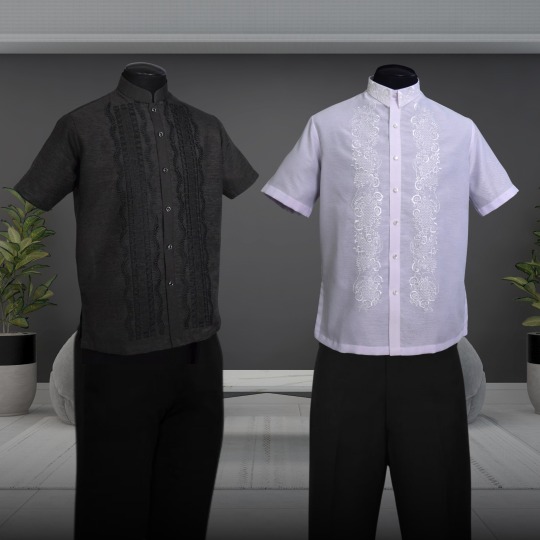
1. Colonial Influence and Early 20th Century: Reinterpretation Post-Revolution
At the turn of the 20th century, after the Philippine Revolution (1896–1898) and the country’s shift from Spanish rule to American colonization, the Barong Tagalog began to gain prominence as a symbol of Filipino resistance and national identity. The garment, which had once been associated with colonial subjugation, became a powerful emblem of Filipino pride and cultural assertion.
Early 1900s (Post-Revolutionary Period):
Return to Tradition: Following the revolution, the Barong Tagalog was reinterpreted by Filipino elites as a garment that expressed nationalism. It was no longer worn solely by the lower classes or as a sign of colonial oppression but became a symbol of the growing Filipino elite’s sense of identity and cultural pride.
American Colonial Influence: During the American colonial period (1898-1946), the Barong Tagalog experienced Western influence. While the American administration encouraged Western-style suits and uniforms, the Barong Tagalog remained important for formal occasions. It was worn by politicians, diplomats, and businessmen in place of the Western suit, creating a distinct Filipino sartorial identity.
2. The Mid-20th Century: The Rise of Piña and Embroidery
The mid-20th century was marked by refinement in the Barong Tagalog’s materials and design, which aligned with broader trends in global fashion. As the Philippines gained independence in 1946, the Barong Tagalog continued to adapt, becoming a more formal and prestigious garment.
1940s–1950s:
Fabric Refinement: Piña (pineapple fiber), long valued for its lightness, texture, and elegance, became the most iconic fabric used for the Barong Tagalog. The intricate hand-embroidery also began to reach new heights in terms of artistry, with Filipino artisans adding detailed, intricate patterns, often reflecting regional styles. These features made the Barong more suited for high-end formal occasions, such as weddings, state functions, and official engagements.
Celebrity and Political Influence: Political figures, such as Manuel Roxas (the first President of the independent Third Republic of the Philippines) and Ferdinand Marcos, wore Barong Tagalog during official events. The Barong Tagalog became the de facto formal wear for Filipino men in positions of power, cementing its place in the national consciousness.
Filipino Men’s Fashion: The Barong Tagalog gradually evolved from a plain, functional garment into something more fashionable and stylish. By the mid-20th century, it was designed with more embellishments like lace trim, delicate embroidered motifs, and sheer, semi-transparent fabrics. These changes reflected the globalized fashion scene, which was growing increasingly focused on detailed craftsmanship and unique designs.
3. 1960s–1970s: Globalization and Cultural Resurgence
In the 1960s and 1970s, the global fashion world became more aware of traditional garments from various cultures, and the Barong Tagalog, as an important symbol of Filipino heritage, started to gain international recognition.
1960s–1970s:
Cultural Nationalism: The rise of cultural nationalism in the Philippines in the 1960s, spurred by figures like Carlos “Botong” Francisco (a prominent Filipino artist) and Nicolás Zafra (a cultural historian), brought the Barong Tagalog back into the public eye as an expression of Filipino identity. This era was marked by efforts to promote Filipino culture through arts, architecture, and fashion. The Barong became a popular garment for formal gatherings, especially after President Ferdinand Marcos issued an executive order in 1975 urging Filipino men to wear the Barong Tagalog on national holidays like Independence Day.
The Barong in International Fashion: As part of the globalization of fashion, the Barong Tagalog began to make its way into international events. The 1960s and 1970s saw Filipino diplomats and leaders sporting the Barong Tagalog at international conferences, state dinners, and even at UN summits, where foreign dignitaries were encouraged to wear the garment. The World Expo in 1964 in New York, where the Philippines was prominently featured, marked an important moment for the Barong Tagalog in the global spotlight.
Changing Fabric and Style: While piña remained the most prestigious fabric, there was also a move towards using other fabrics such as cotton, organza, and rayon. These fabrics made the Barong Tagalog more affordable and accessible to a wider range of Filipinos while still maintaining its traditional elegance. The designs became simpler, though still retaining elements of embroidery, making the Barong more wearable for casual and semi-formal events.
4. 1980s–1990s: The Barong as a Fashion Statement
By the 1980s and 1990s, the Barong Tagalog had fully entered the global fashion mainstream, adapting to the ready-to-wear movement while retaining its identity as a garment for special occasions. The emergence of fashion designers who embraced Filipino craftsmanship also played a key role in modernizing the Barong Tagalog.
1980s–1990s:
Crossover into Fashion: In the late 20th century, Filipino designers such as Rajo Laurel, Cathy Valencia, and Inno Sotto played a crucial role in modernizing the Barong Tagalog. They experimented with fabric choices, introducing organza, silk, and modern synthetics while preserving the garment’s defining sheer, embroidered look. These modern adaptations allowed the Barong Tagalog to remain a fashionable option for contemporary men’s wear while being rooted in tradition.
Global Recognition and Celebrity Endorsement: International figures, including Hollywood celebrities and foreign diplomats, began to wear the Barong Tagalog at formal events. For example, Imelda Marcos, former First Lady of the Philippines, famously wore the Barong Tagalog during high-profile events, and Filipino-American celebrities such as Lou Diamond Phillips began donning the Barong as a celebration of their cultural heritage. This helped elevate the garment’s status on a global scale.
Filipino-American Influence: The growing Filipino diaspora in the United States also contributed to the Barong Tagalog’s adaptation in the 1980s and 1990s. Filipino-Americans began to wear the Barong at weddings, family reunions, and cultural festivals, where it became a fashion statement blending both traditional and contemporary aesthetics.
5. Late 20th Century to Early 21st Century: The Barong Tagalog as a Formal Staple
As the 21st century dawned, the Barong Tagalog evolved further into a formal yet versatile garment. The garment’s continued popularity and its ability to adapt to modern trends ensured that it remained relevant in Filipino society, even as global fashion trends continued to shift.
1990s–2000s:
Barong in Weddings and Formal Functions: The Barong Tagalog became a popular choice for weddings, particularly in Filipino-American communities. Its light fabric and elegant appearance made it an ideal garment for tropical weddings and formal functions in the Philippines, and it became a mainstay in Filipino society for occasions such as national holidays and state dinners.
Global Fashion Recognition: The Barong Tagalog’s integration into the global fashion lexicon continued as international fashion weeks, like those in New York and Paris, saw designers incorporating Filipino elements into their collections. This led to a growing international appreciation for the Barong Tagalog, both as an ethnic garment and as a timeless fashion piece that combines history, art, and modern sophistication.
The Barong Tagalog’s Enduring Appeal
The Barong Tagalog has successfully adapted to modern trends while preserving its cultural significance. From its post-colonial re-emergence as a symbol of Filipino pride to its modern-day adaptation as a staple of formal Filipino fashion, the Barong Tagalog has remained a symbol of the country’s rich heritage and evolving identity.

Through continuous modernization, including fabric innovation, embroidery techniques, and cultural reinterpretations, the Barong Tagalog has become both a formal garment and an international fashion statement, cementing its place in the global fashion scene. Whether worn during state occasions, cultural festivals, or weddings, the Barong Tagalog is a lasting testament to the resilience, craftsmanship, and beauty of Filipino culture.
#barongtagalog#philippines#barongs#philippine culture#custommadebarongtagalog#filipinopride#madeinthephilippines#filipinoculture#filipinowedding#pinoy#FilipinoWeddingDress#Custommadebarongtagalog#filipinoproduct#kimonadress#filipinoamericans#America#trump#united states of america#politics#fastion#fashion#filipinofashion#filipinostyle#filipino#filipina
0 notes
Text
Vintage Classification
Source:
Fashion and sustainability: Design for Change | Request PDF
The State of Fashion 2024 report | McKinsey
Fashion Since 1900 - UAL Research Online
Cradle to Cradle: Remaking the Way We Make Things (2002) - William McDonough
Fashion sites like Vogue and Harper’s Bazaar provide vintage cultural context
Description and definition of a vintage store (e.g. guide for sellers on Etsy, Depop, etc.)
1. By Era
Vintage clothing is often categorized by the decade it represents, ranging from the 1920s to the 1990s:
1920s:
Style: Art Deco-inspired, flapper dresses, beaded gowns, and feathered accessories.
Key Features: Drop-waist dresses, sequins, and fringe.
Example Designers: Coco Chanel, Jeanne Lanvin.
1930s-1940s:
Style: Practical and elegant, influenced by the Great Depression and World War II.
Key Features: Tea dresses, tailored suits, military-style coats.
Example Designers: Elsa Schiaparelli, Christian Dior (introduced the "New Look" in 1947).
1950s:
Style: Ultra-feminine, with cinched waists and full skirts.
Key Features: A-line dresses, poodle skirts, cat-eye glasses.
Example Designers: Dior, Balenciaga, Givenchy.
1960s:
Style: Mod fashion, pop art influences, and a focus on youth culture.
Key Features: Mini skirts, knee-high boots, bold geometric patterns.
Example Designers: Mary Quant, André Courrèges.
1970s:
Style: Hippie, bohemian, and disco.
Key Features: Flared trousers, fringe jackets, maxi dresses, and psychedelic prints.
Example Designers: Yves Saint Laurent, Halston.
1980s:
Style: Power dressing and bold statements.
Key Features: Shoulder pads, neon colors, leather jackets, oversized blazers.
Example Designers: Vivienne Westwood, Jean Paul Gaultier.
1990s:
Style: Minimalism and grunge aesthetics.
Key Features: Slip dresses, plaid shirts, baggy jeans, denim jackets.
Example Designers: Calvin Klein, Prada, Marc Jacobs.
2. By Origin
Western Vintage:
Features iconic American and European brands such as Levi's (denim), Chanel (classic tweed jackets), and Hermès (scarves).
Japanese Vintage:
Known for its appreciation of craftsmanship and unique subcultures.
Includes brands like Comme des Garçons and Issey Miyake, as well as traditional kimono styles.
Chinese Vintage:
Features traditional cheongsams (qipaos) and Mao-era worker uniforms, often reinterpreted with modern aesthetics.
3. By Style
Bohemian (Boho):
Loose, flowy garments with floral prints, lace, and fringe.
Popular in the 1960s and 70s.
Preppy:
Plaid skirts, sweaters, and loafers inspired by collegiate fashion, particularly from the 1980s.
Punk:
Leather jackets, ripped jeans, and studded accessories, originating in the 1970s.
Disco:
Shiny fabrics, sequins, and flared pants from the 1970s and 80s.
Minimalist:
Simple designs with clean lines, typically associated with the 1990s.
4. By Purpose
Everyday Wear:
Practical items like jeans, T-shirts, and sweaters, designed for casual use.
Formal Wear:
Vintage gowns, cocktail dresses, and tuxedos for special occasions.
Workwear:
Durable vintage pieces like denim overalls, military jackets, and tailored suits.
Accessories:
Scarves, hats, gloves, handbags, and shoes that complement vintage outfits.
5. By Material
Denim:
Classic Levi's jeans and jackets, often from the 1950s or earlier.
Silk:
Popular in dresses and accessories, especially in 1920s and 30s formal wear.
Wool:
Common in vintage coats, suits, and knitwear.
PVC/Sequins:
Found in 1960s and 70s disco-inspired clothing.
6. By Condition
True Vintage:
Authentic items from a specific time period, unaltered and often rare.
Reworked Vintage:
Old items that have been altered or customized, such as adding patches or changing the silhouette.
Inspired Vintage:
Modern reproductions that mimic vintage aesthetics but are newly made.
7. By Subcultural Influence
Rockabilly:
Inspired by 1950s rock and roll culture, featuring polka dots, leather, and bold colors.
Grunge:
Originating in the 1990s, with oversized flannel shirts, ripped jeans, and combat boots.
Military Style:
Vintage army jackets, cargo pants, and bomber jackets, often repurposed for streetwear.
8. By consumer tiers
-Sustainability Perspective
Circular Economy:
Vintage fashion promotes sustainability by reusing and recycling clothing.
Swap and Rental:
Some vintage stores offer clothing swaps or rental services, reducing waste while maintaining a fresh wardrobe.
0 notes